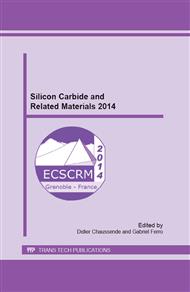p.818
p.822
p.826
p.830
p.834
p.838
p.842
p.847
p.851
Investigation of the Breakdown Voltage in High Voltage 4H-SiC BJT with Respect to Oxide and Interface Charges
Abstract:
Ion implantation in silicon carbide (SiC) induces defects during the process. Implantation free processing can eliminate these problems. The junction termination extension (JTE) can also be formed without ion implantation in SiC bipolar junction transistor (BJT) using a well-controlled etching into the epitaxial base layer. The fixed charges at the SiC/SiO2 interface modify the effective dose of the JTEs, leakage current, and breakdown voltage. In this paper the influence of fixed charges (positive and negative) and also interface trap density at the SiC/SiO2 interface on the breakdown voltage in 4.5 kV 4H-SiC non-ion implanted BJT have been simulated. SiO2 as a surface passivation layer including interface traps and fixed charges has been considered in the analysis. Simulation result shows that the fixed charges influence the breakdown voltage significantly more than the interface traps. It also shows that the positive fixed charges reduce the breakdown voltage more than the negative fixed charges. The combination of interface traps and fixed charges must be considered when optimizing the breakdown voltage.
Info:
Periodical:
Pages:
834-837
Citation:
Online since:
June 2015
Price:
Сopyright:
© 2015 Trans Tech Publications Ltd. All Rights Reserved
Share:
Citation:


